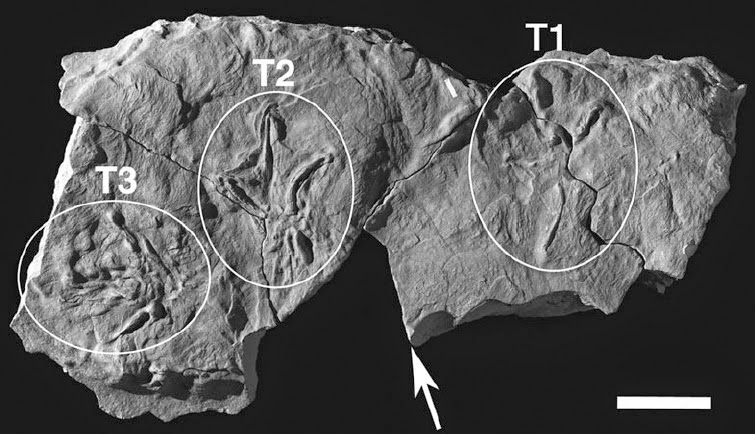The preserved tracks of ancient animals such as Dinosaurs can
provide insights into their lifestyles and biology that could not be determined
by examination of bones alone, although such data needs to be interpreted
carefully. Such studies can potentially provide data on herding or other social
structures among extinct animals, as well as data on the movement of individual
creatures.
In a paper published in the journal Geology on 30 June 2014, Anthony Fiorillo of the Perot Museum of Nature and Science, Stephen Hasiotis of the Department of Geology at the University of Kansas and Yoshitsugu Kobayashi of the Hokkaido University Museum describe a newly discovered Dinosaur trackway in the Denali National Park in Alaska.
The trackway appears to show the movements of a large number of
Hadrosaurid Dinosaurs. It is found in the lower part of the Late Cretaceous
Cantwell Formation, which comprises fluvial (riverine) deposits preserved in a
highly seasonal environment. The site is thought to be close to the same position
that it occupied during the Late Cretaceous, i.e. it would have been within the
Arctic Circle at the time when the tracks were laid down. Arctic ecosystems
during the Cretaceous are thought to have been unlike anything found in the
modern world, as the greenhouse climate of the period prevented the formation
of permanent ice caps, but within the Arctic Circle the winter would still have
been marked by several months of complete darkness.
Polar projection of tectonic plates during the Late
Cretaceous, with inset map of Alaska. NA—North America. Dots in both maps
indicate location of Denali National Park. Fiorillo et al. (2014).
The tracks appear to have been laid down over a short period of time
(based upon analysis of plant and invertebrate fossils in the deposits, which
are thought to have been highly seasonal) leading Fiorillo et al. to conclude they represent the passage of a single herd of
animals. This herd apparently contained individuals with a wide range of sizes,
from mature individuals, to very young juveniles. This is interesting as
Hadrosaurid tracks in more southerly locations have previously shown only
individuals of a single size, suggesting that the animals moved in packs
determined by age. In contrast the Denali Herd appears to have contained
animals of different ages, suggesting that younger animals were incorporated
into a multi-generation herd, which in turn implies that extended parental care
may have been occurring.
(A–C) Size ranges of tracks found at Denali National Park,
Alaska, tracksite. (D) Adult Hadrosaurid track with skin impressions. Scale bar
for (C1) is 5 cm.Fiorillo et al.
(2014).
Fiorillo et al. also
observe that while there appear to have been Hadrosaurs of all sizes in the
pack, the size distribution is skewed towards larger, presumably adult,
specimens. They suggest that this may be indicative of rapid growth in juvenile
Hadrosaurs, with a lifecycle that includes a short growing period followed by
an extended adult phase (something that has been suggested for Hadrosaurs
previously).
Relative frequencies of each growth stage as function of body
mass in the Denali Hadrosaur herd. This curve independently corroborates
hypothesised growth curve for Hadrosaurid dinosaurs proposed by others. Fiorillo et al. (2014).
It has been suggested that Dinosaurs living within the Arctic Circle
may have migrated seasonally to escape the dark winter season, in a similar way
to the long distance migrations of modern Caribou. Based upon our understanding
of the location of the Dinali site during the Cretaceous, and the sizes of the
Dinosaurs within this pack (which affects the distance an animal can migrate by
walking), Fiorillo et al. suggest that
it would have been impossible for the Dinali herd to migrate seasonally from
the site to a location outside the Arctic Circle, suggesting that they were
able to overwinter in the Arctic.
See also…
In 1940 palaeontologist Roland Bird of the American Museum of Natural History
in New York described and partially excavated a...
Dinosaur footprints are well documented from a number of sites...
Follow Sciency Thoughts on Facebook.






